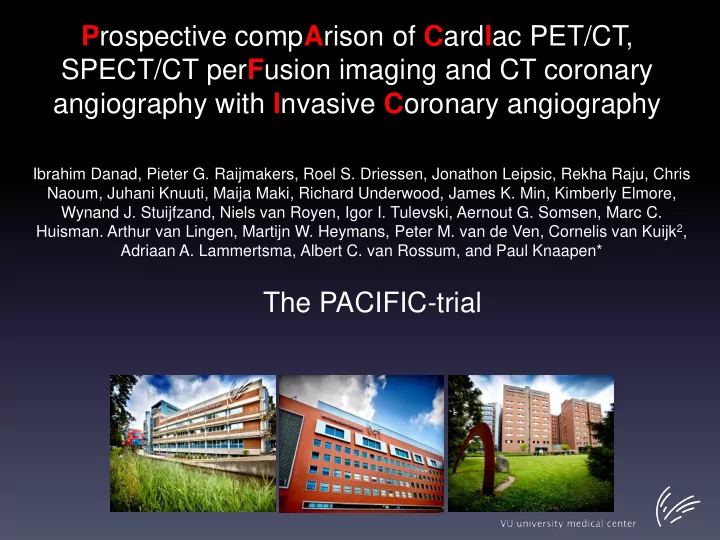

P rospective comp A rison of C ard I ac PET/CT, SPECT/CT per F usion imaging and CT coronary angiography with I nvasive C oronary angiography Ibrahim Danad, Pieter G. Raijmakers, Roel S. Driessen, Jonathon Leipsic, Rekha Raju, Chris Naoum, Juhani Knuuti, Maija Maki, Richard Underwood, James K. Min, Kimberly Elmore, Wynand J. Stuijfzand, Niels van Royen, Igor I. Tulevski, Aernout G. Somsen, Marc C. Huisman. Arthur van Lingen, Martijn W. Heymans, Peter M. van de Ven, Cornelis van Kuijk 2 , Adriaan A. Lammertsma, Albert C. van Rossum, and Paul Knaapen* The PACIFIC-trial
Aim of the study • To determine the diagnostic value, in a true head-to-head fashion, of CCTA, SPECT and PET imaging compared against Fractional Flow Reserve • To assess whether cardiac hybrid imaging has an incremental diagnostic value over stand- alone imaging
Study design Day 1 Adenosine 99m-Tc 140 µg/kg/min LD LD Scout LD Calcium 256-slice CT Stress SPECT CT CT CT scoring CTCA Resting perfusion Stress perfusion 6 min. 2 min. 6 min. Contrast [ 15 O]H 2 O [ 15 O]H 2 O injection Day 2 99m-Tc LD Rest SPECT CT ICA + FFR
Results - Diagnostic accuracy 100 94% 90% 89% 89% 87% 88% CCTA 85% 84% 81% 74%77% 80 SPECT 73% Percentage (%) 64% PET 60% 57% 60 40 20 0 Sensitivity Specificity NPV PPV Accuracy
Results - Diagnostic accuracy hybrid imaging 97% 100 94% 92% Hybrid SPECT/CCTA 88% 84% 82% Hybrid PET/CCTA 76% 80 74% Percentage (%) 71% 60 50% 40 20 0 Sensitivity Specificity NPV PPV Accuracy
Conclusion • This first prospective head-to-head comparative trial revealed PET to exhibit the highest accuracy for diagnosis of myocardial ischemia in patients with an intermediate pre-test likelihood • A combined anatomical and functional assessment does not add incremental diagnostic value and guides clinical decision-making in an unsalutary fashion
Recommend
More recommend